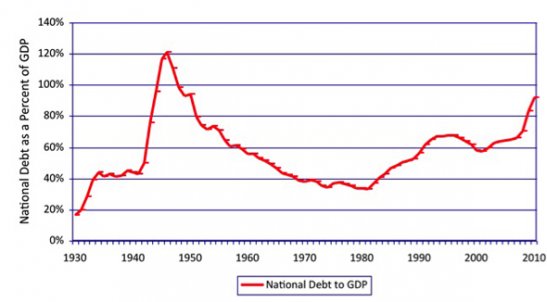Sections
- Total US debt: personal, corporate, government
- Breakdown of US national (i.e. federal government) debt only
- What the national debt doesn’t include
- US: national debt vs. GDP
- International: Government debt vs. GDP
Total US Debt
All told, the total US debt is about:
$55T ~= $16T (personal) + $21.4T (corporate) + $2.5T (state/loc) + $14.7T (nat’l gov’t)
Which includes:
- [$16T] Personal debt held by Americans
- [$13.56T] Mortgage debt (including non-residential mortgages)
- [$2.48T] Consumer debt (including car loans, credit card debt)
- [$21.4T] Corporate debt, including
- [$14.1T] The US financial sector debt
- [$7.3T] Non-financial business debt
- [$2.5T] State and local government debt
- [$14.7T] Federal government debt
Source: The Fed, Flow of Funds Accounts of the United States (2011-Q1)
Breakdown of the US national debt
The US national (federal government) debt is currently just under $14.7 trillion dollars (see also: The Debt to the Penny and Who Holds It). The amount of debt changes every year by the size of the budget deficit (increase!) or surplus (decrease!). The $14.7T is comprised of:
- [~$10.06T] Public debt: Securities issued by the federal government and held by the public (investors, the Federal Reserve, foreign, state, and local governments)
- What? Treasury bills, notes, and bonds (which vary in their duration, among other things)
- See: Top foreign holders of US debt
- [~$4.64T] Intragovernmental debt: Securities issued by the federal government which live in accounts administered by the government.
- What? Government account securities
- Federal Housing Administration
- Federal Savings and Loan Corporation’s Resolution Fund
- Federal Hospital Insurance Trust Fund (Medicare)
- Social Security Trust Fund
Not included in that $14.7T…
The national debt figure does not include:
- Fannie Mae and Freddie Mac obligations: together these accounted for about $5T in September 2008.
- Fannie Mae and Freddie Mac buy mortgages from lending institutions (such as your local bank) so that those institutions can be “freed up” to issue more mortgages or otherwise loan more money.
- But are these obligations actually guaranteed? No.
- Freddie Mac securities are not funded or protected by the US Government and they carry no government guarantee of being repaid.
- Freddie Mac states, “securities, including any interest, are not guaranteed by, and are not debts or obligations of, the United States or any agency or instrumentality of the United States other than Freddie Mac.”
- There is a widespread belief that Freddie Mac securities are backed by some sort of implied federal guarantee and a majority of investors believe that the government would prevent a disastrous default.
- Source: http://en.wikipedia.org/wiki/Freddie_Mac
- Guaranteed obligations:
- Unfunded obligations: Not included in the national debt are the obligations (under law) for payments the US government must make to Medicare, Medicaid, and Social Security.
- [$7.7T] Social Security
- [$38.2T] Medicare and Medicaid
- The cost of these programs far exceeds tax revenues for the next 75 years.
- The Medicare payouts already exceed the tax revenues intended to pay for Medicare. Similarly, social security payouts for a given year already exceed payroll taxes for that year.
- With the baby boomers nearing retirement (and redemption of their Social Security retirement payments), that these liabilities are unfunded looms large and imminent.
Over the years: US national debt versus GDP
Below picture is over a longer time horizon (starting from the 30s)… but with less precision on the actual value of the ratio; also, this graph stops at 2010.
http://www.businessinsider.com/federal-government-budget-overview-2011-1?op=1
The below graph is over a shorter time horizon (than the above); note that this graph doesn’t include the spike in the 40s, which was related to WWII spending (I assume!). Also, this includes current and near-term debt-to-GDP ratios (inching toward 100%).
Credit: http://populicio.us/2009/06/
Over the years: international government debt versus GDP
How does the US debt-to-GDP ratio compare to that of other countries? (Lower is better!)
See also:




Hi, this is a comment.
To delete a comment, just log in, and view the posts’ comments, there you will have the option to edit or delete them.
Pingback: World Economic Forum: Why international cooperation is needed to solve the global economic crisis | Kitchen Table News